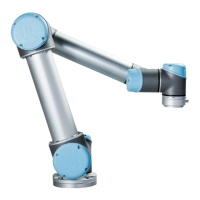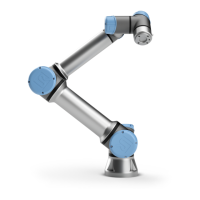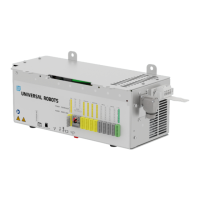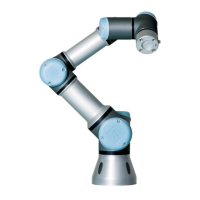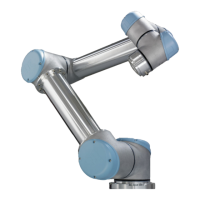12.2 Pose Editor Screen
Use the drop down menu above the RX, RY and RZ boxes to choose the orientation representa-
tion. Available types are:
• Rotation Vector [rad] The orientation is given as a rotation vector. The length of the axis is
the angle to be rotated in radians, and the vector itself gives the axis about which to rotate.
This is the default setting.
• Rotation Vector [
◦
] The orientation is given as a rotation vector, where the length of the
vector is the angle to be rotated in degrees.
• RPY [rad] Roll, pitch and yaw (RPY) angles, where the angles are in radians. The RPY-
rotation matrix (X, Y’, Z” rotation) is given by:
R
rpy
(γ, β, α) = R
Z
(α) · R
Y
(β) · R
X
(γ)
• RPY [
◦
] Roll, pitch and yaw (RPY) angles, where angles are in degrees.
Values can be edited by clicking on the coordinate. Clicking on the + or - buttons just to the
right of a box allows you to add or subtract an amount to/from the current value. Pressing
and holding down a button will directly increase/decrease the value. The longer the button is
down, the larger the increase/decrease will be.
Joint positions
Allows the individual joint positions to be specified directly. Each joint position can have a
value in the range from −360
◦
to +360
◦
, which are the joint limits. Values can be edited by
clicking on the joint position. Clicking on the + or - buttons just to the right of a box allows
you to add or subtract an amount to/from the current value. Pressing and holding down a
button will directly increase/decrease the value. The longer the button is down, the larger the
increase/decrease will be.
OK button
If this screen was activated from the Move tab (see 13.1), clicking the OK button will return to the
Move tab, where the robot arm will move to the specified target. If the last specified value was a
tool coordinate, the robot arm will move to the target position using the MoveL movement type,
while the robot arm will move to the target position using the MoveJ movement type, if a joint
position was specified last. The different movement types are described in 14.4.
Cancel button
Clicking the Cancel button leaves the screen discarding all changes.
Version 3.11
Copyright © 2009–2019 by Universal Robots A/S. All rights reserved.
II-33 e-Series
